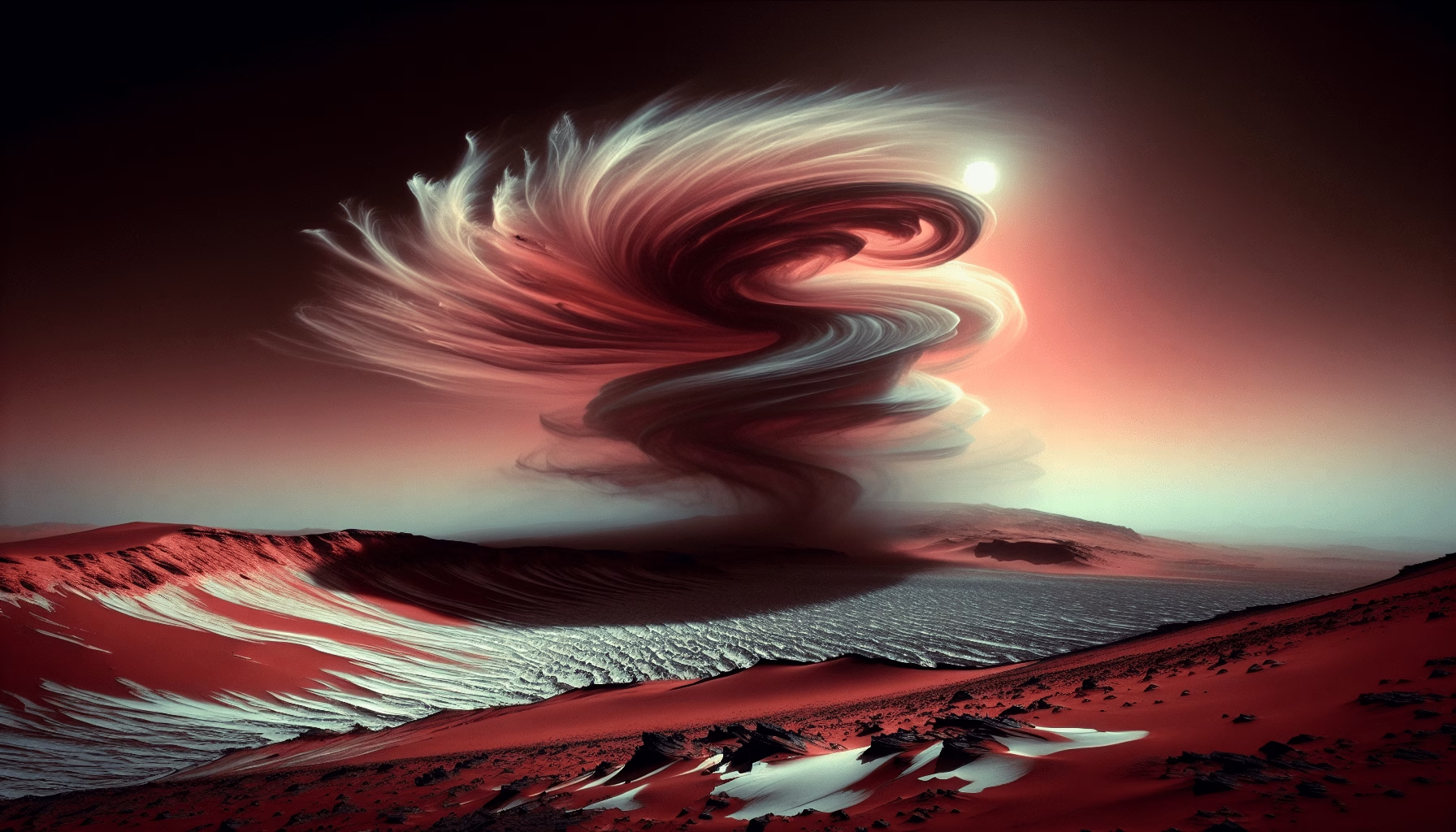Have you ever wondered about the fascinating weather patterns that occur on Mars? While Earthlings obsess over rain showers and hurricanes, the Red Planet has its own atmospheric marvels. This article delves into the wonders of Martian weather, focusing on the intricate phenomena of dust devils and ice caps. These elements not only paint the Martian landscape and atmosphere in shades of mystery but also provide crucial insights into the planet’s geological and atmospheric processes. As a professional, you will gain a comprehensive understanding of these two significant features, allowing you to grasp the broader implications of Martian meteorology.

Table of Contents
Understanding Martian Weather: An Introduction
When considering Martian weather, one must first grasp the fundamental differences between Earth’s atmosphere and that of Mars. Thin and primarily composed of carbon dioxide, the Martian atmosphere is about 100 times less dense than that of Earth. This significantly affects the planet’s weather patterns, making them unique and intriguing study subjects. Despite the sparse atmosphere, Mars displays a variety of weather phenomena, with dust storms being one of the most dramatic. The weather on Mars shapes not only the planet’s surface features but also its potential to support life in the distant future.
The Role of Mars’s Atmospheric Composition
The composition of Mars’s atmosphere is pivotal in understanding its weather phenomena. With approximately 95% carbon dioxide, 2.6% nitrogen, and trace amounts of water vapor, argon, and oxygen, Mars presents a stark contrast to Earth. This composition results in a much lower atmospheric pressure, allowing winds to pick up and transport fine dust particles over vast distances. The unique makeup also contributes to temperature dynamics that influence weather patterns significantly.
The Influence of Mars’s Orbit and Tilt
Mars’s elliptical orbit and axial tilt play crucial roles in its weather systems. The planet’s orbit causes notable seasonal variations, with extreme differences in temperature between the summer and winter months. Mars’s axial tilt, similar to Earth’s, leads to seasonal changes that affect its polar ice caps, increasing their size during winter due to temperatures plummeting to –195°F (–125°C). These seasonal dynamics are crucial for understanding the development of various Martian weather phenomena, including the formation and behavior of dust devils and ice caps.
Dust Devils: Mars’s Whirling Vortexes
Martian dust devils are akin to their earthly counterparts. However, due to Mars’s lower gravity and thinner atmosphere, they appear more massive and can last longer. These swirling columns of dust can reach impressive heights and play a pivotal role in shaping the Martian surface and atmosphere.
Formation of Dust Devils
The formation of dust devils on Mars occurs when solar heating causes a temperature difference on the surface, creating an updraft of warm air. This process instigates a rotating motion as cooler air rushes in to replace the warm air rising. The lower atmospheric pressure coupled with the fine Martian dust amplifies the dust devil’s visibility and impact.
Impact on Mars’s Surface and Atmosphere
Dust devils are significant because they contribute to the continual reshaping of the Martian landscape. They sweep and remove surface dust, revealing new geological features and altering the albedo (reflectivity) of the planet’s surface. The lofted dust also impacts the climate by influencing the atmospheric temperature and dynamics, affecting Mars’s weather patterns. Scientists monitor these dust devils to gather data on the surface and atmospheric conditions, which are critical for future Mars exploration missions.
Observations and Measurements
Scientific exploration of dust devils is often conducted via Mars rovers and orbiters. Instruments aboard these spacecraft record images and data on dust devil activity, providing insights into their frequency, size, and seasonal variations. These observations assist researchers in understanding wind patterns and atmospheric circulation on Mars, significantly enhancing our comprehension of Martian meteorology.

The Phenomenon of Martian Ice Caps
Although Mars is famously associated with its dusty, red appearance, its polar ice caps are equally fascinating. These features are predominantly composed of frozen water and carbon dioxide and undergo cyclical changes, which are crucial in studying Martian climate and potential water reserves.
Structure and Composition of Ice Caps
Mars’s polar ice caps consist of layered deposits of water ice and dry ice (frozen carbon dioxide). The northern cap, primarily water ice, remains larger and more stable, while the southern cap showcases a higher proportion of carbon dioxide. In winter, the caps dramatically expand as temperatures drop, with carbon dioxide sublimating directly from gas to solid to form thin ice sheets.
Seasonal and Long-term Changes
The Martian seasons drive significant transformations in the polar ice caps. During the Martian summer, carbon dioxide sublimates from the cap, causing it to shrink, while in winter, it refreezes, expanding the cap. Furthermore, long-term changes may provide clues to the planet’s historical climate patterns. Understanding these cycles can help you appreciate the complexity and dynamism of Martian climate systems.
Significance for Martian Exploration
The ice caps on Mars are not mere aesthetic features; they are the focus of scientific curiosity because they hold the potential for containing ancient climatic records. Analyzing these layers could offer insights into past environmental changes and climate cycles on Mars, providing treasured information about the planet’s geological history and its habitability prospects.
Implications for the Future of Mars Exploration
Mars’s weather phenomena, such as dust devils and ice caps, present unique challenges and opportunities for future exploration missions. Understanding these elements is pivotal for any crewed or uncrewed mission aiming to explore or establish a presence on Mars.
Navigational and Operational Challenges
Dust devils, for instance, present hazards similar to dust storms in terms of navigation and operational functionality for rovers and future human habitats. Understanding the patterns and frequencies aids in mitigating risks associated with equipment malfunctions or the accumulation of dust on solar panels.
Potential for Resource Utilization
The polar ice caps hold promise as potential water resources essential for human colonization. Efficient methods to extract and utilize this water would be pivotal in sustaining long-term human presence on Mars. Ongoing studies of the ice caps’ structure and composition are thus crucial components of mission planning and resource management.
Increasing Earthly Understanding of Climate Systems
Studying Martian weather phenomena offers broader implications for understanding climate systems beyond Earth. Insights gained from Martian atmospheric patterns can inform climate models, helping you comprehend global weather phenomena on Earth and other planets.

The Broader Implications of Martian Weather Studies
Exploring the wonders of Martian weather is not just an academic exercise; it has profound implications for planetary science and enhances Earth’s scientific knowledge base.
Advancing Planetary Climatology
Investigations into Martian weather enrich the field of planetary climatology, enabling scientists to draw parallels and distinctions between different celestial bodies. This knowledge adds depth to our understanding of how atmospheric dynamics interact with surface conditions across diverse environments.
Considerations for Astrobiology
Dust devils and ice caps may also factor into astrobiological investigations. The possibility of life on Mars, past or present, remains a tantalizing question in science. Mars’s unique weather phenomena could influence the distribution and accessibility of potential biological markers or resources requisite for life.
Contributions to Global Climate Models
Studying Mars’s weather contributes to refining climate models used for Earth and other planets. As you compare Martian and Earth weather systems, you gain valuable insights into atmospheric processes applicable in diverse planetary contexts, thereby enhancing predictive models used both on Earth and in space exploration.
Closing Thoughts on Martian Weather Phenomena
In summary, the wonders of Martian weather reveal a planet with climatic processes as complex and dynamic as its landscape is desolate and beautiful. Dust devils and ice caps provide a window into understanding a world dramatically different from our own, yet eerily comparable in certain respects. As you engage with the mysteries of Martian weather, you are invited to view the Red Planet not merely as a distant destination but as an active participant in the cosmic dance of climate and geology. By appreciating these planetary dynamics, you contribute to the broader endeavor of exploring, understanding, and possibly one day living among the stars.
Embrace this journey of discovery and consider how these phenomena fit into the wider narrative of planetary science, inviting further exploration and innovation. Now, reflect on these insights and ponder how future technological advances might unravel even more mysteries of Mars. How might our knowledge of Martian weather continue to evolve, and what could this mean for humanity’s future on the Red Planet? You are at the forefront of this exciting scientific frontier, standing alongside pioneers charting the course for our next terrestrial adventure.

Hubble Finds Cloudy, Cold Weather Conditions for Mars-Bound Spacecraft

